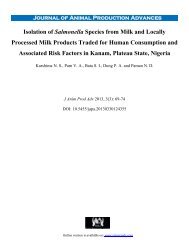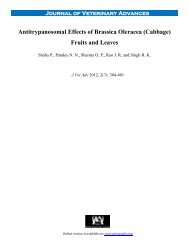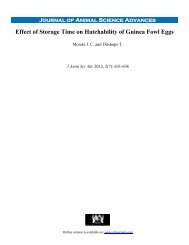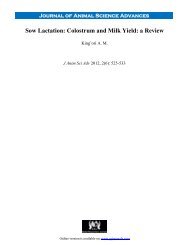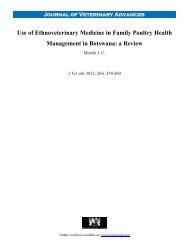PDF Download
PDF Download
PDF Download
Create successful ePaper yourself
Turn your PDF publications into a flip-book with our unique Google optimized e-Paper software.
Journal of Animal Production Advances<br />
Cold Active β-Galactosidase of Hafnia Alvei KNOUC302<br />
Isolated from Raw Milk: Identification of the Bacteria,<br />
Cloning Partial Gene of β-Galactosidase in Escherichia Coli<br />
Nam E. S. and Ahn J. K.<br />
J Anim Prod Adv 2012, 2(2): 101-108<br />
Online version is available on: www.grjournals.com
ISSN: 2251-7677<br />
NAM AND AHN<br />
Original article<br />
Cold Active β-Galactosidase of Hafnia Alvei<br />
KNOUC302 Isolated from Raw Milk: Identification<br />
of the Bacteria, Cloning Partial Gene of β-<br />
Galactosidase in Escherichia Coli<br />
1 Nam E. S. and *2 Ahn J. K.<br />
1 Sogang-Binggrae Food Advanced Analysis Center, Sogang University, Seoul 121-742, Republic of Korea<br />
2 Department of Agricultural Sciences, Korea National Open University, Seoul 110-791, Republic of Korea<br />
Abstract<br />
Psychrophilic bacteria producing lactose hydrolyzing enzyme were isolated from the samples of raw milk<br />
collected from dairy farms of Kyung-gi province in Korea. Among isolated strains, KNOUC302 showing the<br />
best activity of lactose hydrolysis was identified, and its β-galactosidase gene was cloned. This strain was<br />
aerobic, asporogenic bacilli, immobile, Gram negative, catalase positive and oxidase positive. It grew optimally<br />
at 20 ºC and pH=7.0-7.2. The composition of major fatty acids in the cell membrane of KNOUC 302, were C 12:0<br />
(10.2 %), C 14:0 3OH (25.41 %), C 16:0 (9.94 %) and C 16:1 ω 7 c (29.75 %). Based on morphological and biochemical<br />
properties, the strain could be identified as Hafnia sp. and finally as Hafnia alvei by phylogenetic analysis based<br />
on 16S rDNA sequence. A part of β-galactosidase gene, 779 bp, coding 296 a.a from N-terminal of the β-<br />
galactosidase was isolated from Hafnia alvei KNOUC302 by partial digestion of chromosomal DNA with<br />
Sau3AI and cloned in E. coli Top 10F’. The incomplete gene of 779 bp was supplemented, from vector during<br />
cloning, with 109 bp nucleotides providing terminal codon to a complete ORF (KNOUC302 β-gal). The gene<br />
(KNOUC302 β-gal) consists of 918 bp encoding the protein of 306 amino acids and 34,806 Da of deduced Mw.<br />
Key words: Psychrophilic, β-galactosidase gene, Hafnia alvei, cloning<br />
* Corresponding author: ajk@knou.ac.kr<br />
Received on: 06 Jan 2012<br />
Revised on: 26 Jan 2012<br />
Accepted on: 29 Jan 2012<br />
Online Published on: 01 Feb 2012<br />
101 J. Anim. Prod. Adv., 2012, 2(2):
COLD ACTIVE β–GALACTOSIDASE OF HAFNIA ALVEI KNOUC302 ISOLATED FROM …<br />
Introduction<br />
Psychrophiles exhibiting optimal growth at low<br />
temperature (1) produce cold-adapted enzymes,<br />
which exhibit high catalytic activities at low<br />
temperature to adapt to cold habitats, and thus,<br />
psychrophiles have attracted attention as sources of<br />
enzymes with potential for low-temperature<br />
catalysis (2). Many psychrophiles were reported to<br />
produce variety of cold-active enzymes useful in<br />
food processing, biomass conversion, molecular<br />
biology, environmental biosensors, bioremediation,<br />
cleaning of contact lense, and several other<br />
processes (3-7).<br />
In particular, cold active enzymes are attractive<br />
in food industry for the processing of fruit juices<br />
and milk, because there is an increasing industrial<br />
trend to treat food stuffs under mild conditions to<br />
avoid spoilage, changes in taste and nutritional<br />
values at ambient temperature, and because coldactive<br />
enzymes can be inactivated at moderate<br />
temperatures without harsh heating treatment (8, 9).<br />
Among cold-active enzymes, β-galactosidase<br />
(EC.3.2.1.23), which hydrolyzes lactose to glucose<br />
and galactose, is one of the important foodindustrial<br />
enzymes. It can be used to degrade<br />
lactose for several purposes; e.g., (1) removal of<br />
lactose from refrigerated milk for people who are<br />
lactose intolerant, (2) conversion of lactose to<br />
glucose and galactose, which are more fermentable<br />
sugars than lactose, and (3) removal of lactose from<br />
pollutants of dairy industry (10).<br />
There have been many reports on cold active β-<br />
galactosidase from psychrotrophic bacteria of<br />
Arthrobacter psychrolactophilus (11),<br />
Carnobacterium pisciocola BA (12) and<br />
Pseudoalteromonas haloplakis (2), Planococcus<br />
(13), and a psychotropic yeast of Guehomyces<br />
pullulans (7). The genes coding cold active β-<br />
galactosidase have been detected in Arthrobacter<br />
sp. (14), Carnobacterium sp. (12) and Planococcus<br />
sp. (13). However there has not been a useful one<br />
yet for application in milk processing and further<br />
research is required to find a proper one for<br />
practical use.<br />
We isolated a psychrophilic bacteria, Hafnia<br />
alvei, producing β-galactosidase, cloned gene of the<br />
enzyme in E. coli, and the results are being<br />
reported.<br />
Materials and Methods<br />
Screening and cultivation condition<br />
Raw milk samples produced at dairy farms of<br />
Northern Kyunggi province in Korea were used for<br />
isolation of psychrophilic bacteria hydrolysing<br />
ONPG and lactose. Milk sample was enriched in the<br />
Brain heart infusion broth (BHI; Difco<br />
Laboratories, Detroit, Mich) containing 1 % (w/v)<br />
lactose, and incubated at 4 ºC aerobically by<br />
shaking (200 rpm) for 30 days, and spread on BHI<br />
agar containing 1 % (w/v) lactose, and 0.01 % (w/v)<br />
5-bromo-4-chloro-3-indolyl-β-D-galactopyranoside<br />
(X-gal; Duchefa Biochemei, Holland). After<br />
incubation at 15 ºC for 3 days, blue colonies were<br />
selected, and then cultivated in Brain heart infusion<br />
broth and agar for determining β-galactosidase<br />
activity and identification.<br />
Assay of β-galactosidase activity<br />
β-galactosidase activity was determined by<br />
measuring the hydrolysis of o-nitrophenyl -Dgalactopyranoside<br />
(ONPG; Sigma) as the substrate<br />
by the procedure presented by Miller (15). An<br />
aliquot of cell free extracts (0.5 mL) was added to<br />
2.5 mL of ONPG solution (0.04 M, in Na-phosphate<br />
buffer of 0.01 M and pH 6.8) and incubated at 4 ºC<br />
for 2 hrs. The reaction was stopped by addition of 3<br />
mL of 0.5 M Na 2 CO 3 and the absorbance at 420 nm<br />
was measured. One unit of enzyme activity is<br />
defined as the activity hydrolyzing 1μmol of ONPG<br />
per min by cell free extract from 1 mL of culture<br />
cell whose A 600 was adjusted to 8.0. Hydrolysis of<br />
lactose was measured by glucose detection kit<br />
(Glucose B-test Wako; Wako Pure Chemicals<br />
Industries, Ltd, Osaka, Japan). 0.04 mL of cell free<br />
extracts was added to 1.6 mL of skim milk, and<br />
incubated for 5 days at 4 ºC. One unit of activity for<br />
hydrolysis of lactose was defined as the amount of<br />
enzyme producing 1 μmol of glucose per day by 1<br />
mL of cell culture whose A 600 was 8.0.<br />
Morphological and biochemical<br />
characterization of microorganism<br />
Among isolated strains, the strain showing the<br />
highest β-galactosidase activity was identified by<br />
102 J. Anim. Prod. Adv., 2012, 2(2):101-108
Gram staining, morphological, biochemical, and<br />
physiological tests. Cell was grown on BHI agar to<br />
determine optimum growth condition for<br />
temperature (5-40 ºC) and in BHI broth for pH(4.0-<br />
8.0). pH of BHI broth was adjusted with HCl or<br />
NaOH. Acid production from carbohydrate, and<br />
utilization of sole carbon sources were determined<br />
using API tests (BioMerieux), including API 20E<br />
(identification system for Enterobacteriaceae and<br />
other Gram-negative rods) and API 20NE<br />
(identification system for gram-negative nonenterobacterial<br />
rods) galleries.<br />
Analysis of cellular fatty acid composition<br />
The cell biomass for cellular fatty acid<br />
composition analysis was collected from BHI agar<br />
plates after incubation for 5 days. Cells were<br />
harvested, and the cellular fatty acid was saponified,<br />
methylated and extracted following the instructions<br />
in the manual for Sherlock Microbial Identification<br />
System (MIDI, USA). The fatty acids were<br />
analyzed by gas chromatography (Hewlett Packard<br />
6890, USA) and identified using the Microbial<br />
Identification software package (16).<br />
Determination of 16S rDNA sequence and<br />
phylogenetic analysis<br />
Genomic DNA was isolated, and 16S rDNA<br />
was amplified by PCR and sequenced following the<br />
method described by Rainey et al. (17). Universal<br />
primers of fD1 (5’-GAGTTTGATCCTGGCTCAG-<br />
3’) and rD1 (5’-AGAAAGGAGGTGATCCAGCC-<br />
3’) were used for PCR. PCR products were purified<br />
by ethanol precipitation and electrophoresis with a<br />
model 377 Genetic Analyzer (Perkin-Elmer Co.).<br />
The 16S rDNA sequence was aligned against the<br />
previously determined sequences in Ribosomal<br />
Data of GenBank. The phylogenetic tree for the<br />
dataset was inferred using the neighbor-joining<br />
method (18).<br />
Assaying effect of temperature and pH on the<br />
β-galactosidase activity<br />
Effect of temperature on β-galactosidase<br />
produced in cell free extracts of KNOUC 302 was<br />
analyzed by measuring the enzyme activity at<br />
various temperatures (4 to 60 ºC) in 0.01 M sodium<br />
phosphate buffer (pH 6.8). Optimum pH for the β-<br />
galactosidase activity was determined by measuring<br />
the activity at various pHs(4.6 to 9.6) at 4 ºC in<br />
103 J. Anim. Prod. Adv., 2012, 2(2):<br />
NAM AND AHN<br />
sodium acetated buffer (0.01 M, pH 4.25-pH 6.0)<br />
and sodium phosphate buffer (0.01 M, pH 6.0-pH<br />
7.68). Enzyme stability was determined by<br />
measuring the residual activity during incubation of<br />
cell free extracts of KNOUC302 in sodium<br />
phosphate buffer (0.01 M, pH6.8) at 4 ºC and 37 ºC<br />
for 7 days.<br />
Cloning and sequence determination of β-<br />
galactosidase gene<br />
The chromosomal DNA of strain KNOUC302<br />
cells was isolated using a Genomic DNA Prep Kit<br />
(A&A Biotechnology, Poland) according to the<br />
protocol for gram-negative bacteria. The DNA was<br />
partially digested using Sau3A1 endonuclease, and<br />
4-10 kb fragments were collected and purified after<br />
electrophoresis in 0.8 % agarose gel using the DNA<br />
Gel Out Kit (A&A Biotechnology, Poland). To<br />
prepare genomic library, these DNA fragments<br />
were ligated into BamH1 site in pRSET (Promega,<br />
USA), transformed to E. coli TOP10F’ and<br />
incubated at 15 ºC for 3 days on LB agar containing<br />
100 ug ampicillin/mL, 100 ug/mL X-Gal without<br />
addition of IPTG. Colony was randomly taken for<br />
analysis. Sequence of the cloned DNA fragment<br />
was determined using Big Dye Automatic<br />
sequencer ABI 377 (Perkin Elmer, USA) and<br />
PE9600 Thermocycler (Perkin Elmer, USA).<br />
Results and Discussion<br />
Isolation and identification of bacterium<br />
producing cold-active β-galactosidase<br />
From raw milk samples collected from dairy<br />
farms of Northern Kyunggi province in Korea. 11<br />
strains having the activity of X-gal hydrolysis at 4<br />
ºC were isolated and KNOUC302 showed a good<br />
activity of ONPG hydrolysis and the highest<br />
activity of lactose hydrolysis (Table 1). Strain<br />
KNOUC302 was chosen, and it’s 16S rDNA,<br />
morphological and biochemical properties were<br />
examined for identification. The 16S rDNA of<br />
strain KNOUC302 was composed of 1,498bp<br />
(GenBank accession No. JN014467). BLAST<br />
searching revealed the highest similarity of 16S<br />
rDNA of strain KNOUC302 with those of<br />
Obesumbacterium proteus DSM 2777 T (98.9%<br />
identity) and Hafnia alvei ATCC 13337 T (99.8%<br />
identity) in phylogenetic tree (Fig. 1).<br />
Obesumbacterium sp. and Hafnia alvei are closely
COLD ACTIVE β–GALACTOSIDASE OF HAFNIA ALVEI KNOUC302 ISOLATED FROM …<br />
related to each other (19). However<br />
Obesumbacterium has different shape of long<br />
pleomorphic rod with that of Hafnia forming<br />
uniformly rod shape (20), and most strains of<br />
Obesumbacterium ferment only D-mannose and<br />
trehalose, rarely other carbohydrates including<br />
lactose (21, 22).<br />
Table 1: Hydrolysis of ONPG and lactose of isolated<br />
strains from raw milk<br />
No. Strain No.<br />
Hydrolysis of<br />
ONPG 1) Lactose 2)<br />
1 KNOUC301 0.024 N.D<br />
2 KNOUC302 0.530 28.073<br />
3 KNOUC303 0.770 N.D<br />
4 KNOUC304 0.557 14.194<br />
5 KNOUC305 1.087 3.943<br />
6 KNOUC306 1.407 N.D<br />
7 KNOUC307 1.118 18.932<br />
8 KNOUC308 1.098 N.D<br />
9 KNOUC309 0.533 N.D<br />
10 KNOUC310 0.309 N.D<br />
11 KNOUC311 0.425 N.D<br />
1)<br />
One unit of enzyme activity is defined as the activity<br />
hydrolyzing 1μmol of ONPG per min by cell free extract from<br />
1ml of culture whose A 600 is 8.<br />
2) One unit of enzyme activity is the one hydrolyzing 1μmol of<br />
lactose per day at 4℃ by cell free extracts from 1ml of culture<br />
whose A 600 is 8.<br />
acids of Hafnia alvei α773 were reported to be C 16:0 ,<br />
C 16:1 , C 17:0 and 18:1 (24). Though cellular fatty acids<br />
composition of KNOUC 302 does not completely<br />
coincide with those of Hafnia alvei α773, the<br />
morphological and biochemical properties of<br />
KNOUC302 are matching well to the result of<br />
phylogenetic analysis presenting that strain<br />
KNOUC is genetically close to Hafnia alvei ATCC<br />
13337. Therefore, strain KNOUC302 would be the<br />
species Hafnia alvei. We finally identified<br />
KNOUC302 as Hafnia alvei, and named the strain<br />
as Hafnia alvei KNOUC302.<br />
Effect of temperature and pH on β-<br />
galactosidase in cell free extract of KNOUC302<br />
The selected strain, KNOUC302 was tested on<br />
optimum temperature and pH, and stability for its β-<br />
galactosidase in crude cell extracts. The optimal<br />
temperature and pH of strain KNOUC302 β-<br />
galactosidase in cell free extracts was 15 ºC and<br />
pH7.5 (Fig. 2). The β-galactosidase retended 80%<br />
activity of optimum temperature at 4 ºC and 10 ºC<br />
and 60 % activity of optimum pH at pH of milk (pH<br />
6.8). Stability of the β-galactosidase was examined<br />
by incubating at 4 ºC and 37 ºC for 7 days. The β-<br />
galactosidase was stable at 4 ºC for 7 days, but its<br />
activity decreased to less than 60 % of initial<br />
activity in 7 days at 37 ºC(Fig. 2). The properties of<br />
KNOUC302 β-galactosidase are satisfying the<br />
requirements for hydrolysis of lactase in milk at low<br />
temperature. Psychrotrophic bacteria, Planococcus<br />
sp. L4 (25) and Arthrobacter sp. (26, 27) produced<br />
β-galactosidase whose optimum temperature and<br />
optimum pH were 20 ºC and pH 6.8, and 10-15 ºC<br />
and pH 8 respectively. However other<br />
psychrotrophic bacteria, Arthrobacter<br />
psychrolactophilus (11), Carnobacterium pisciocola<br />
BA (12), Pseudoalteromonas haloplakis (2) and<br />
Planococcus sp. (13) produced β-galactosidase<br />
reacting optimally at high temperature of 40 ºC, 30<br />
ºC, 45 ºC and 42 ºC respectively. The β-<br />
galactosidase of Arthrobacter psychrolactophilus<br />
(11), Pseudoalteromonas haloplakis (2) and<br />
Planococcus sp. (13) reacted optimally at pH 7.2,<br />
pH 6.4, pH 8 and pH 6.4 respectively. Optimum<br />
temperature and pH of β-Galactosidase of<br />
Enterobacter cloacae, belonging to the same family<br />
with strain KNOUC 302 were 50 ºC and pH 9.0<br />
(27).<br />
As in Table 2 presenting morphological<br />
biochemical properties, the strain KNOUC302 was<br />
Gram negative, rod, nonsporing, facultative<br />
anaerobic, oxidase negative, and reduced nitrate to<br />
nitrite. These properties classify KNOUC302 as<br />
family Enterobacteriaceae (22), and uniformly red<br />
shape of KNOUN302 and utilization of many<br />
carbohydrates by KNOUC302 let KNOUC302 be<br />
out of genus Obesumbacterium. KNOUC302 failed<br />
in production of indole and H 2 S, and was negative<br />
in fermentation of raffinose, sorbitol, and inositol<br />
that are the typical characteristics of Genus Hafnia<br />
(23). And KNOUC302 showed negativity in indole<br />
production and urease, and positivity in hydrolysis<br />
of PNPG and ONPG that are fitting to species<br />
Hafnia alvei (21, 23). The main fatty acids of<br />
KNOUC 302 cell were C 12:0, C 14:0 3-OH, C 16:0 and<br />
C 16:1 ω 7 c comprising 10.2 %, 25.41 %, 9.94 % and<br />
29.75 % respectively (Table 3). The main fatty<br />
104 J. Anim. Prod. Adv., 2012, 2(2):101-108
NAM AND AHN<br />
Table 2: Morphological and biochemical properties of the strain KNOUC 302<br />
Characteristics Reaction Characteristics Reaction<br />
Gram staining<br />
Shape<br />
Motility<br />
Spore formation<br />
Oxidation-fermentation<br />
Optimum temp.<br />
Optimum pH<br />
Growth at 5℃<br />
37℃<br />
Catalase<br />
Oxidase<br />
Hydrolysis of PNPG<br />
ONPG<br />
Nitrate reduction<br />
Indol production<br />
H2S formation<br />
Citrate utilization<br />
Urease<br />
β-Hemolysis<br />
MacConkey<br />
Utilization of D-glucose<br />
Mannitol<br />
-<br />
Rod<br />
-<br />
-<br />
O/F<br />
20℃<br />
6.8~7.2<br />
+<br />
-<br />
+<br />
-<br />
+<br />
+<br />
+<br />
-<br />
-<br />
-<br />
-<br />
-<br />
+<br />
+<br />
+<br />
Maltose<br />
Rhamnose<br />
Sucrose<br />
Mannose<br />
Galactose<br />
Gelatin<br />
Lactose<br />
Fructose<br />
Xylitol<br />
Ducitol<br />
Adonitol<br />
Raffinose<br />
Glycerol<br />
Erythrol<br />
Acetylglucosamine<br />
Starch<br />
Amigdalin<br />
Tagatose<br />
Sorbitol<br />
Xylose<br />
Arabinose<br />
+<br />
+<br />
-<br />
+<br />
-<br />
-<br />
+<br />
-<br />
-<br />
+<br />
-<br />
-<br />
-<br />
-<br />
+<br />
-<br />
-<br />
+<br />
-<br />
+<br />
+<br />
Presumptive identification<br />
Hafnia sp.<br />
+, positive reaction; -, negative reaction<br />
66.0<br />
80.7<br />
0.01<br />
98.5<br />
99.9<br />
100<br />
Obesumbacterium proteus DSM 2777 T (AJ233422)<br />
Hafnia alvei ATCC 13337 T (M59155)<br />
KNOUC302<br />
Yersinia pestis D-28 (X75274)<br />
Rahnella aquatica DSM 4594 T (AJ233426)<br />
Serratia marcescens DSM 30121 T (AJ233431)<br />
Serratia rubidaea DSM 4480 T (AJ233436)<br />
Erwinia amylovora DSM 30165 T (AJ233410)<br />
Klebsiella pneumoniae DSM 30104 T (AJ233420)<br />
Citrobacter freundii DSM 30039 T (AJ233408)<br />
Pectobacterium carotovorum DSM 30168 T (AJ233411)<br />
Pectobacterium cacticidum LMG 17936 T (AJ223409)<br />
Brenneria salicis DSM 30166 T (AJ233419)<br />
Vibrio cholerae CECT 514 T (X76337)<br />
Fig. 1: Phylogenetic tree based on 16S rDNA sequences showing the positions of strain KNOUC302, the representative<br />
of some other related taxa. Bootstrap values (1000replicatioons) are shown as percentage at each node only if they are 50<br />
% greater. Scale bar represents 0.01 substitutions per nucleotide position.<br />
105 J. Anim. Prod. Adv., 2012, 2(2):
Residual activity(%)<br />
Relative activity(%)<br />
Relative activity (%)<br />
COLD ACTIVE β–GALACTOSIDASE OF HAFNIA ALVEI KNOUC302 ISOLATED FROM …<br />
Cloning β-galactosidase gene of strain<br />
KNOUC302 in E. coli<br />
In the prepared genomic library, there was a<br />
colony having the vector harboring an ORF coding<br />
a protein of β-galactosidase. The ORF is composed<br />
of 888 bp encoding 295 amino acids whose deduced<br />
Mw is 33,709 Da (Fig. 3). But the ORF is not a<br />
complete β-galactosidase gene of Hafnia alvei<br />
KNOUC302. The front sequence of 779 bp,<br />
beginning from initial codon, was from<br />
chromosome of Hafnia alvei KNOUC302, and the<br />
rear sequence of 109 bp to terminal codon was from<br />
vector (pRSET). The nucleotide was named as<br />
KNOUC302 β-gal. A BLAST search in the<br />
databases of NCBI revealed that the 779 bp front<br />
sequence of KNOUC302 β-gal coded the amino<br />
terminal of β-galactosidase belonging to glycoside<br />
hydrolase family 2. The front 779 bp sequence of<br />
KNOUC302 β-gal, from chromosome of Hafnia<br />
alvei KNOUC302, showed the following identities<br />
to β-galactosidase genes from microorganisms of<br />
family Enterobacteriaceae: Escherichia coli K12<br />
(297/401, 74 %, GenBank Accession No.<br />
AP009378), Rahnella sp. Y9602 (364/485, 75 %,<br />
GenBank Accession No. CP002505), Serratia<br />
proteamaculans 568(311/409, 76 %, GenBank<br />
Accession No. CP000826) and Enterobacter<br />
aerogenes KCTC2190 (289/388, 74 %, GenBank<br />
Accession No. CP002824).<br />
galactosidase of Arthrobacter sp. 32c (29),<br />
Pseudoalteromonas haloplanktis (2) and<br />
Planococcus sp. L4 (25) were 2085 bp, 3117 bp and<br />
2031 bp respectively.<br />
100<br />
80<br />
60<br />
40<br />
20<br />
0<br />
0 10 20 30 40<br />
100<br />
80<br />
60<br />
40<br />
20<br />
120<br />
100<br />
Temp.<br />
0<br />
4 5 6 7 8<br />
pH<br />
Table 3: Composition of major fatty acids of strain<br />
KNOUC302<br />
Fatty acid Contents (%)<br />
C 12:0 10.20<br />
C 14:0 6.31<br />
C 14:0 3OH 25.41<br />
C 16:1 ω 7 c 29.75<br />
C 16:0 9.94<br />
C 18:1 ω 7 c 5.05<br />
The size of β-galactosidase genes from Escherichia<br />
coli K12 (GenBank Accession No. AP009378),<br />
Rahnella sp. Y9602 (GenBank Accession No.<br />
CP002505), Serratia proteamaculans 568(GenBank<br />
Accession No. CP000826) and Enterobacter<br />
aerogenes KCTC2190 (GenBank Accession No.<br />
CP002824) were 3075 bp, 3099 bp, 3090 bp and<br />
3108 bp respectively. Genes encoding cold active β-<br />
0<br />
0 1 2 4 7<br />
Fig. 2: Effects of temperature (A) and pH (B) on the<br />
activity, and stability (C) of β-galactosidase in cell free<br />
extracts of Hafnia alvei KNOUC302.<br />
* Effect of temperature was tested in Na-phosphate buffer<br />
(0.01 M, pH= 6.8).<br />
* Effect of pH was examined in Na-acetate (0.01 M) for<br />
pH=4.25 to 6.0, and in Na-phosphate buffer (0.01 M) for pH<br />
6.0 to 7.68 at 4 ℃.<br />
* Values are means of triplicates ± S.D.<br />
106 J. Anim. Prod. Adv., 2012, 2(2):101-108<br />
80<br />
60<br />
40<br />
20<br />
Days
NAM AND AHN<br />
Conclusion<br />
In this study, Hafnia alvei KNOUC302, a strain<br />
that produces lactose hydrolyzing enzyme at low<br />
temperature, was isolated from the samples of raw<br />
milk collected from dairy farms of Kyung-gi<br />
province in Korea. The results obtained in this study<br />
show that Hafnia alvei KNOUC302 grew optimally<br />
at 20 ºC and pH=7.0-7.2. The gene (KNOUC302 β-<br />
gal) consists of 918 bp encoding the protein of 306<br />
amino acids and 34,806 Da of deduced Mw. In the<br />
search for cold-adapted β-galactosidase, we<br />
conclude that the β-D-galactosidase from Hafnia<br />
alvei KNOUC302 is a cold-active enzyme, and that<br />
the enzyme could have advantageous applications in<br />
the food industry, the treatment of chilled dairy<br />
products while avoiding flavor tainting and the risk<br />
of microbial contamination.<br />
References<br />
Fig. 3: DNA sequence of Hafnia alvei KNOUC302 β-<br />
galactosidase gene (KNOUC302β-gal) and deduced<br />
amino acid sequence.<br />
*The fragment from pRSET vector came from pRSET C,<br />
cloning vector.<br />
Bondarenko VM, Afanas’eva SM, Vasiurenko ZP (1982).<br />
Heterogeneity of the fatty acid composition of bacteria in<br />
the genera Klebsiella, Enterobacter, Hafnia and Serratia.<br />
Zurnal mikrobiologii I immunobiologii., 12 : 54-60.<br />
Brenner DJ, Farmer JJ (2005). Family I. Enterobacteriaceae.<br />
In: Bergey’s Manual of Systematic Bacteriology, Vol. 2,<br />
D.J. Brenner, N.R. Krieg, J.T. Staley(Eds.), Williams &<br />
Wilkins, Baltimore pp. 587-607.<br />
Coombs JM, Brenchley JE (1999). Biochemical and<br />
phylogenetic analyses of a cold-active β-galactosidase<br />
from the lactic acid bacterium Carnobacterium piscicola<br />
BA, Appl. Environ. Microbiol., 65 : 5443-5450.<br />
Farmer JJ, Brenner DJ (2005). Genus XXII.<br />
Obesumbacterium. In: Bergey’s Manual of Systematic<br />
Bacteriology, Vol. 2, D.J. Brenner, N.R Krieg, J.T. Staley<br />
(Eds.), Williams &Wilkins, Baltimore pp. 710-713.<br />
Feller G, Narinx E, Arpigny JL, Aittaleb M, Baise E, Genicot<br />
S, Gerday C (1996). Enzymes from psychrophilic<br />
organisms. FEMS Microbiol. Rev., 18: 189-202.<br />
Ghatak A, Guha AK, Ray L (2010). β-D-Galactosidase from<br />
Enterobacter cloacae: production and some<br />
physicochemical properties. Appl. Biochem. Biotechnol.,<br />
165 : 1678-1688.<br />
Gerday C, Aittaleb M, Bentahir M, Chessa JP, Claverie P,<br />
Collins T, D’Amico SM, Dumont J, Garsoux G, Georlette<br />
D, Hoyoux AT, Lonhienne T, Meuwiw, MA, Feller G<br />
(2000). Cold-adapted enzymes from fundamentals to<br />
biotechnology. Trends in Biotechnol., 18 : 103-107.<br />
Gutshall KR, Trimbur DE, Kasmir JJ, Brenchley JE (1995).<br />
Analysis of a novel gene and β-galactosidase isoenzyme<br />
from a psychrophilic Arthrobacter isolate. J. Bacteriol.,<br />
177 : 1981-1988.<br />
Hildebrandt P, Wanarska M, Kur J (2009). A new coldadapted<br />
β-D-galactosidase from the Antarctic Arthrobacter<br />
107 J. Anim. Prod. Adv., 2012, 2(2):
COLD ACTIVE β–GALACTOSIDASE OF HAFNIA ALVEI KNOUC302 ISOLATED FROM …<br />
sp. 32c-gene cloning, overexpression, purification and<br />
properties. BMC Microbiol., 9 : 151-162.<br />
Holt JG, Krieg NR, Sneath PH, Staley JT, Williams ST<br />
(1994). Group 5 Facultatively anaerobic Gram negative<br />
rods, In: Bergey’s Manual of Determinative Bacteriology,<br />
Williams & Wilkins, Baltimore pp. 175-289.<br />
Hoyoux A, Jennes I, Dubiose P, Genicot S, Dubaik P,<br />
Francoi, JM (2001). Cold-adapted β-galactosidase from the<br />
Antarctic psychrophile Pseudoalteromonas haloplanktis.<br />
Appl. Environ. Microbiol., 67 : 1529-1535.<br />
Hu JM, Li H, Cao LX, Wu PC, Zhang PC, Sang SI, Zhang<br />
XY, Chen MJ, Lu JQ, Liu YH (2007). Molecular cloning<br />
and characterization of the gene encoding cold-active betagalatosidase<br />
from a psychtrophic and halotolerant<br />
Planococcus sp. L4. J. Agri. Food Chem., 55 : 2217-2224.<br />
Loveland J, Gutshall K, Kasmie J, Prema P, Brenchley JE<br />
(1994). Characterization of psychotropic microorganism<br />
production β-galactosidase activities. Appl. Environ.<br />
Microbiol., 60(1) : 12-18.<br />
Margesin R, Schinner F (1994). Properties of cold-adapted<br />
microorganisms and their potential role in biotechnology.<br />
J. Biotechnol., 33 : 1-14.<br />
Marshall CJ (1997). Cold-adapted enzymes, Trend in<br />
Biotechnol., 15 : 359-364.<br />
Miller JH (1972). Experiments in molecular genetics. In: Cold<br />
Spring Harbor Laboratory, Cold Spring Harber, N.Y.<br />
Morita RY (1975). Psychrophilic bacteria. Bacteriol. Rev., 39<br />
: 144-167.<br />
Nakagawa T, Fujimoto Y, Ikehata R (2006a). Purification and<br />
molecular characterization of cold-active β-galactosidase<br />
from Arthrobacter psychrolactophilus strains F2. Appl.<br />
Microbiol. Biotechnol. 72 : 720-725.<br />
Nakagawa T, Fujimoto Y, Uchino M (2003). Isolation and<br />
characterization of psychrophiles producing cold-active β-<br />
galactosidase. Lett. Appl. Microbiol., 37 : 154-157.<br />
Nakagawa T, Ikehata R, Uchino M, Miyaji T, Takano K,<br />
Tomizuka N (2006b). Cold-active β-galactosidase activity<br />
of isolated psychrophilic-basido mycetous yeast<br />
Guehomyces pullulans, Microbio. Res., 161 : 75-79.<br />
Priest FG, Somerville HJ, Cole JA, Hough JS (1973). The<br />
taxonomic position of Obesumbacterium proteus, a<br />
common brewery contaminant. J. Gen. Microbiol., 75 :<br />
295-307.<br />
Rainey FA, Ward-Rainey N, Kroppenstedt RM, Stackebrandt<br />
E (1996). The genus Nocardiopsis represents a<br />
phylogenetically coherent taxon and a distinct<br />
actinomycete lineage: proposal of Nocardiopsacease fam.<br />
Nov, Int. Syst. Bacteriol., 46 : 1088-1092.<br />
Russell NJ (1998). Molecular adaptations in psychrophilic<br />
bacteria: potential for biotechnological applications. Adv.<br />
Biochem. Engineering Biotechnol., 61 : 1-21.<br />
Saitou N, Nei M (1987) The neighbor-joining method: a new<br />
method for reconstruction phylogenetic trees. Mol. Biol.<br />
Evol., 4 : 406-424.<br />
Sakazaki R (2005). Genus XV. Hafnia. In: Bergey’s Manual<br />
of Systematic Bacteriology Vol. 2, D.J. Brenner, N.R.<br />
Krieg, J.T. Staley (Eds.), Williams & Wilkins, Baltimore<br />
pp. 681-685.<br />
Sasser M (1990). Identification of bacteria by gas<br />
chromatography of cellular fatty acids. MIDI Technical<br />
Note No.101. Newark. DE: MIDI Inc., USA.<br />
Sheridan PP, Brenchley JE (2000). Characterization of a salttolerant<br />
family 42 β-galactosidase from a psychrophilic<br />
Antarctic Planococcus isolate, Appl. Environ. Microbiol.<br />
66 : 2438-2444.<br />
Trimbur DE, Gutshall KR, Prema P, Brenchley JE (1994).<br />
Characterization of a psychrophilic Arthrobacter gene and<br />
its cold-active β-galatosidase, Appl. Environ. Microbiol.,<br />
60 : 4554-4558.<br />
Xu K, Tang X, Gai Y, Mehmood M, Xiao X, Wang F (2011).<br />
Molecular characterization of cold-inducible β-<br />
galactosidase from Arthrobacter sp. ON14 isolated from<br />
Antarctica. J. Microbiol. Biotechnol., 21 : 236-242.<br />
108 J. Anim. Prod. Adv., 2012, 2(2):101-108





